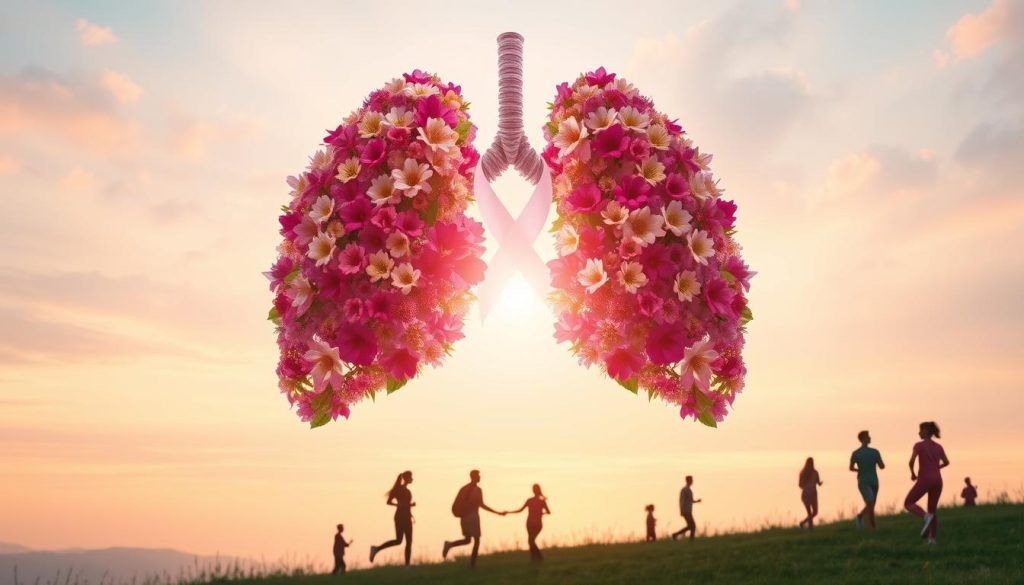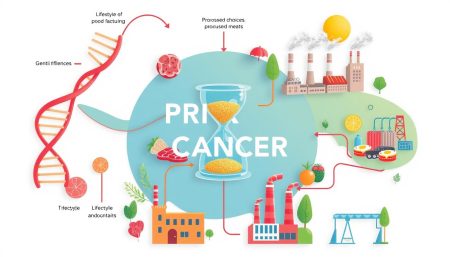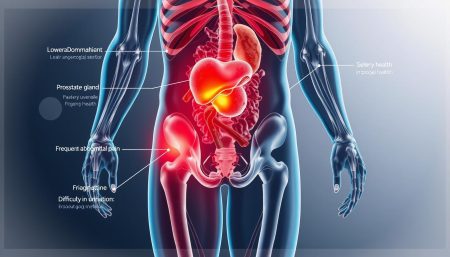Lung cancer is a serious health issue that can cause worry and uncertainty. Yet, knowing about it can help a lot. This talk is about the key to finding lung cancer early, which is very important.
By learning about the signs of lung cancer, we can help people get better sooner. This is all about spreading the word about lung cancer. It’s about giving hope to those who are looking for answers.
Key Takeaways
- Recognizing early detection of lung cancer is critical for improving survival rates.
- Awareness of the subtle signs of lung cancer can lead to timely diagnosis and treatment.
- Lung cancer might not always make a grand entrance; its symptoms can be mistaken for less serious conditions.
- Fostering lung cancer awareness is essential in empowering individuals to take proactive health measures.
- Early intervention is the strongest weapon in the battle against lung cancer, emphasizing the importance of regular health check-ups.
Understanding Lung Cancer and Its Prevalence
Lung cancer is a big problem worldwide. It’s important to know the basics, look at the statistics, and understand the risk factors. This helps us raise awareness and work on prevention.
The Basics of Lung Cancer
Lung cancer happens when cells in the lungs grow out of control. It mainly affects the cells lining the airways. There are two main types: small cell lung cancer (SCLC) and non-small cell lung cancer (NSCLC). NSCLC makes up about 85% of cases.
The growth of lung cancer is linked to genetic changes. These changes are often caused by exposure to harmful substances for a long time.
Statistics: Incidence and Mortality Rates
Lung cancer is a leading cause of death globally. It’s more deadly than other cancers. Despite new treatments, survival rates are still low. This is mainly because it’s often diagnosed too late.
Risk Factors for Developing Lung Cancer
Knowing the risk factors is key to preventing and catching lung cancer early. Smoking is the biggest risk. Exposure to radon, asbestos, and other work-related dangers also increases the risk. Genetic factors and a history of lung diseases play a role too.
| Risk Factor | Impact Level | Preventive Measures |
|---|---|---|
| Smoking | High | Smoking cessation programs |
| Radon Exposure | Medium to High | Regular home radon testing |
| Genetic Factors | Variable | Genetic counseling and testing |
| Asbestos Exposure | Medium to High | Compliance with safety regulations |
| Previous Lung Diseases | Medium | Regular medical check-ups |
Recognizing Lung Cancer Symptoms
The journey to find lung cancer starts with knowing its signs. Spotting lung cancer early can lead to better treatments and outcomes. We will look at common and subtle symptoms that might make you think you need to see a doctor.
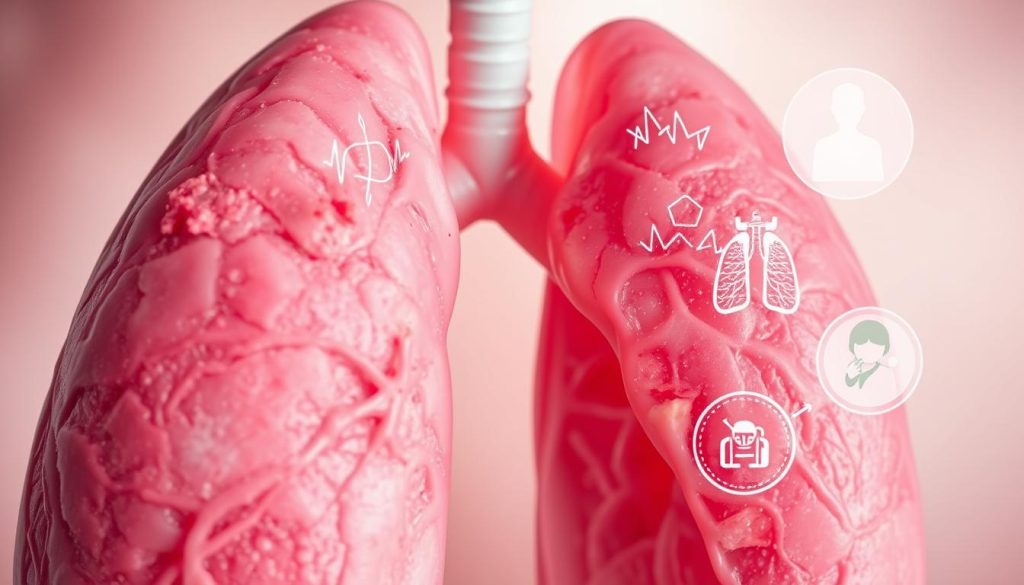
Common symptoms include a persistent cough, changes in coughing, and trouble breathing. But, these signs can also mean less serious health issues. This makes it hard to know if you have lung cancer without a doctor’s check-up.
- Persistent cough that does not improve
- Breathing difficulties, such as shortness of breath
- Chest pain or discomfort, especially when breathing or coughing
- Unexpected weight loss and loss of appetite
- Hemoptysis – coughing up blood
It’s key to spot lung cancer signs early. But, it’s also important to know how to tell if these symptoms are from something serious or not.
| Symptom | Possible Lung Cancer Sign | Common Benign Causes |
|---|---|---|
| Persistent Cough | Yes | Cold, Flu, Allergies |
| Chest Pain | Yes | Muscle Strain, Acid Reflux |
| Weight Loss | Yes | Diet Changes, Stress |
| Breathing Difficulty | Yes | Asthma, COPD, Infection |
As shown in the table, figuring out what’s causing a symptom can be tricky. It often takes careful checking and sometimes, many tests. Many people have shared how catching lung cancer early helped them get better faster.
Remember, never ignore persistent symptoms, as they are the key to early lung cancer detection. If you notice any of the aforementioned signs, consult a healthcare professional to discuss the need for further evaluation.
Persistent Cough as a Warning Sign
A persistent cough is often seen as just a cold or a seasonal thing. But, if it doesn’t go away, it might be a sign of something serious like lung cancer. We’ll look into when a cough becomes a warning sign, focusing on the signs of a cancerous cough.
When to Be Concerned About a Cough
The length and how bad a cough is can tell us a lot. Doctors say if a cough lasts more than three weeks, you should see a doctor. Symptoms like chest pain, wheezing, or losing weight without trying to are also big red flags.
Distinguishing Between a Regular Cough and a Cancerous Cough
To spot a cancerous cough, look for these signs:
- Persistence: A cough that’s there every day for a long time, getting worse at night.
- Type of Cough: A dry cough or one that brings up blood or rust-colored mucus is a warning.
- Associated Symptoms: Hoarseness, trouble breathing, and often getting chest infections are also signs to watch.
Knowing these cough warning signs can help catch problems early. It can lead to quicker, better care that might save lives.
Chest Pain and Lung Cancer Symptoms
It’s important to know how chest pain and lung cancer pain are linked. This knowledge helps in getting a quick diagnosis and managing symptoms of lung cancer. Chest pain from lung cancer can be sharp, aching, or constant. It’s different from pain from less serious issues.
This pain often comes from tumors pressing on nearby tissues. It can also happen if cancer spreads to the chest wall or ribs. Pain usually gets worse when you breathe deeply, cough, or laugh.
- Persistent, unexplained chest pain
- Increased severity with deep breaths or coughs
- Localized pain that may increase with movement or touching the area
Symptoms of lung cancer like chest pain can really affect your life. It’s not just physical; it’s also emotional. People often feel anxious about the possibility of a serious illness.
| Type of Chest Pain | Associated Conditions | Characteristics |
|---|---|---|
| Cardiac Pain | Heart conditions | Pressure-like, squeezing, radiating to other body areas |
| Lung Cancer Pain | Lung Cancer | Sharp, persistent, localized |
| Musculoskeletal Pain | Strain, injury | Dull, aching, increased with movement |
Knowing the difference can help you get the right medical help faster. This is key for early detection and treatment of lung cancer.
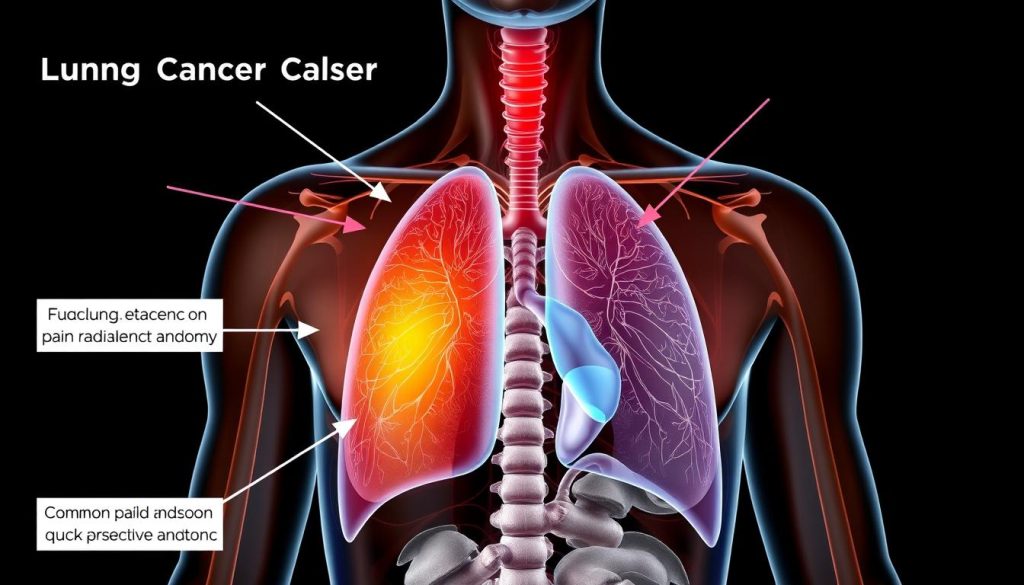
Shortness of Breath: What It Could Signal
Feeling short of breath can be scary and might mean serious health problems, like lung cancer. This symptom is key in spotting possible lung cancer respiratory symptoms. It urges us to look closer at our breathing health.
How Lung Cancer Affects Respiratory Function
Lung cancer can really hurt how well our lungs work, causing many breathing issues. Tumors can block airways or press on the lungs, leading to shortness of breath. This happens because our lungs can’t fully expand, making it hard to breathe and get oxygen.
Identifying Abnormal Breathing Patterns
Abnormal breathing patterns often show lung cancer’s effect on breathing. Look out for signs like wheezing, fast breathing, or constant trouble breathing. These signs might mean there’s a tumor or blockage in the lungs.
Spotting these signs early can save lives. If you notice changes in breathing or keep feeling short of breath, see a doctor right away. They can do tests like imaging to find out what’s wrong and plan treatment.
Wheezing and Stridor in Lung Cancer Patients
The sounds of wheezing and stridor can be scary and might mean serious illnesses like lung cancer. It’s key to know about these lung cancer breathing sounds for early detection and treatment. Wheezing makes a high-pitched sound because airways are narrowed. Stridor, a harsh sound, points to a blockage in the big airways.
Wheezing and stridor are serious because they show air passage blockages, possibly from tumors. These sounds are not like normal breathing or common respiratory issues like asthma or infections.
- Wheezing: Often occurs when exhaling; can be episodic or chronic, depending on the extent of airway obstruction.
- Stridor: Usually heard during inhalation; indicates a blockage in the upper airway.
If you notice these symptoms, see a doctor right away. For more on lung cancer, check out guides on blood cancer and other malignancies. It helps understand related health issues better.
| Sound Type | Description | Possible Indicative Condition |
|---|---|---|
| Wheezing | High-pitched sound, mostly during exhalation | Lung cancer, Asthma, COPD |
| Stridor | Loud, harsh grating noise during inhalation | Lung cancer, Tracheal obstruction |
Spotting lung cancer breathing sounds like wheezing and stridor helps catch the disease early. It also shows the need for a doctor’s check-up to find the right treatment or more tests.
Lung Cancer Symptoms: Fatigue and Weakness
Cancer fatigue and cancer-related weakness are tricky symptoms of lung cancer. They often feel like just being tired. But, it’s important to understand them well for early detection and treatment.
The Impact of Cancer on Energy Levels
Lung cancer can make you feel much more tired than usual. This fatigue doesn’t go away with rest or sleep. It can make it hard to do everyday things.
Differentiating Cancer Fatigue from Ordinary Tiredness
It’s key to tell cancer fatigue apart from just feeling tired. Cancer fatigue is a deep exhaustion that affects your mind and emotions. It’s different from regular tiredness.
| Aspect | Ordinary Tiredness | Cancer Fatigue |
|---|---|---|
| Duration | Often resolved with rest | Long-lasting, not relieved by rest |
| Impact on Activities | Moderate, often can still perform tasks | Severe, significantly hinders daily activities |
| Associated Symptoms | Generally isolated | Often accompanied by pain, emotional distress |
| Treatment Response | Improves with sleep and stress management | Requires comprehensive medical management |
Knowing the differences helps spot lung cancer early. This can lead to better treatment and outcomes. If you’re always tired and can’t shake it off, see a doctor for a check-up.
Weight Loss and Appetite Changes
When it comes to lung cancer metabolism, some symptoms might hint at bigger health problems. Unexplained weight loss and appetite changes are key signs. They could be early signs of lung cancer, often missed until it’s too late.
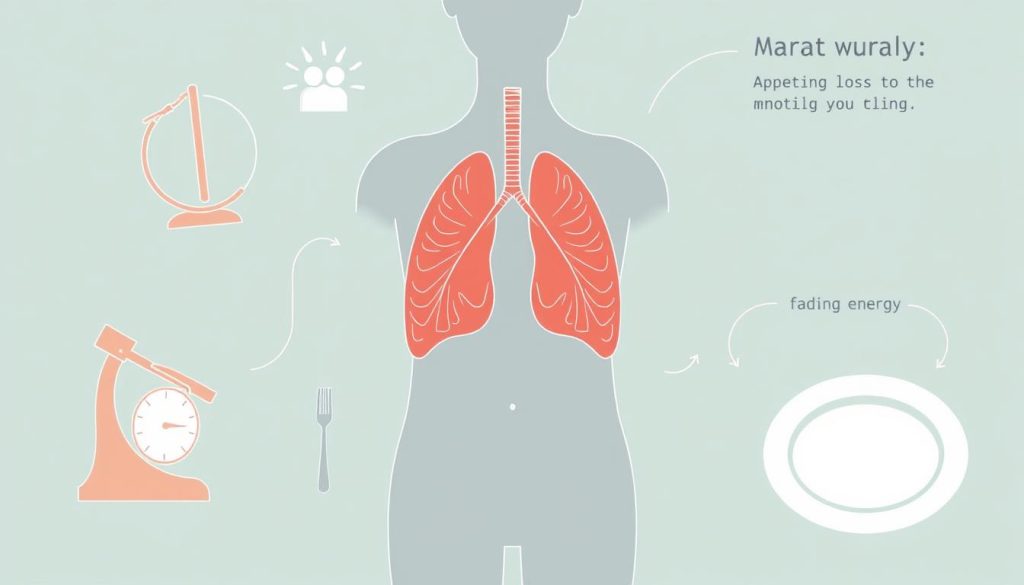
It’s important to know the difference between unexplained weight loss and normal weight changes. This type of weight loss happens without diet or exercise changes. It can be sudden and significant. Lung cancer metabolism might affect how the body uses food, leading to weight loss.
Appetite changes in lung cancer patients might include wanting to eat less and feeling full quickly. These changes are complex but often linked to the cancer’s effect on metabolism. Spotting these signs early is key for timely diagnosis and treatment.
| Symptom | Potential Impact on Patient | Relation to Lung Cancer |
|---|---|---|
| Unexplained Weight Loss | Loss of body mass without dietary changes | Indicative of alterations in cancer metabolism |
| Appetite Changes | Decreased eating and early satiety | Could be caused by tumor-related biochemical changes |
If you’re experiencing these symptoms, see a doctor right away. Talking about these signs can lead to early checks and lifesaving actions. For more on these signs and why early detection matters, check out the discussion on colon cancer symptoms.
Coughing Up Blood: When to Seek Help
Coughing up blood is a scary symptom, especially for those at risk for lung cancer. This symptom, known as hemoptysis, can signal serious health issues. It’s important to seek medical help right away.
Understanding Hemoptysis
Hemoptysis can range from small blood flecks to larger amounts. While it might seem minor, it can be a sign of lung cancer. It’s key to recognize this symptom and understand its impact on lung health.
Managing Blood in Cough: Medical Advice and Procedures
Seeing a doctor is crucial if you cough up blood. They will check you thoroughly to find the cause and how serious it is. They might suggest tests like chest X-rays or CT scans based on your history and the amount of blood.
- Consult a doctor immediately if you notice any amount of blood in your cough.
- Follow through with the recommended diagnostic tests to determine the cause.
- Discuss all possible treatment options and follow-up procedures with your healthcare provider.
Seeing hemoptysis as a warning sign for serious health issues, like lung cancer, is vital. It encourages quick action. This can greatly improve outcomes by starting treatment early.
Frequent Lung Infections and Their Correlation with Lung Cancer
Recurrent lung infections can be a worry for doctors. They might show signs of lung cancer. Lung infection and cancer correlation is a key area of study. This is because lung cancer can weaken the immune system, making infections more common.
Doctors see patterns in lung infections to spot lung cancer early. The lung cancer immune response is key. It helps fight cancer and infections.
- Increased susceptibility to infections due to impaired lung tissue.
- Chronic inflammation from infections might help cancer grow.
- Recurring infections could mean lung function is failing, needing tests like imaging and biopsies.
Knowing these signs and seeing a doctor quickly can lead to early diagnosis. This is crucial for effective treatment and a better outcome.
Patients with a history of recurrent lung infections should discuss the possibility of underlying lung cancer with their healthcare provider, especially if they are accompanied by other symptoms like unexplained weight loss or chronic fatigue.
| Condition | Impact on Immune System | Possible Indication |
|---|---|---|
| Recurrent Lung Infections | Reduction in immune efficacy | Need for detailed pulmonary assessment |
| Lung Cancer | Compromised immune response | Potential for frequent infections |
This table shows how lung conditions affect the immune system. It’s vital to watch these conditions closely and get help from doctors.
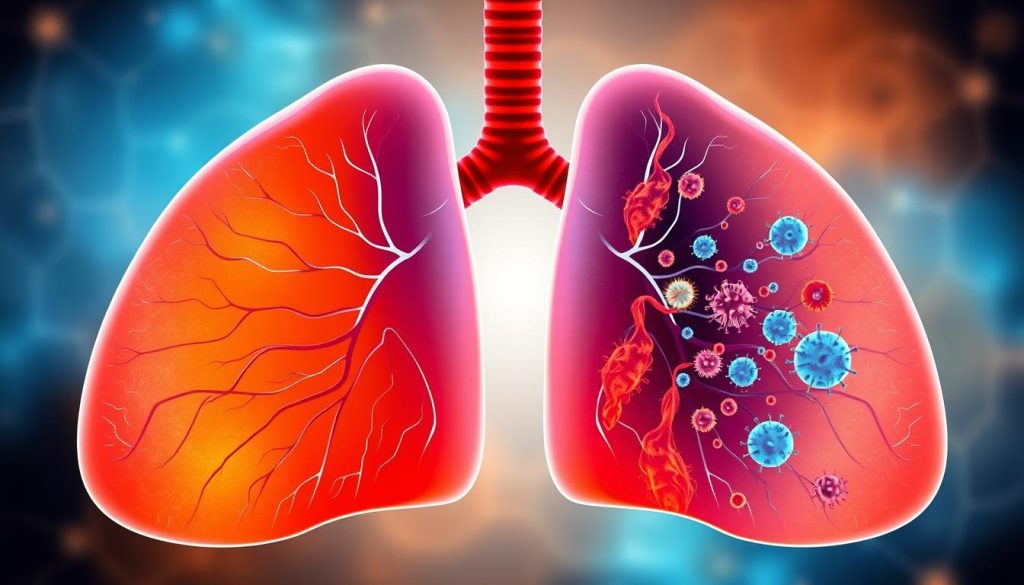
Bone Pain and Lung Cancer’s Spread
Understanding bone pain and lung cancer involves looking at cancer metastasis. This is when cancer cells spread from the lung to other parts of the body. Bone pain often shows this spread. It can tell us about the stages of lung cancer, especially when other advanced lung cancer symptoms are present.
Recognizing Metastasis in Lung Cancer
Cancer metastasis in lung cancer often affects bones, brain, liver, and other organs. Bones are a common site. When cancer cells invade bone tissue, they cause pain, fractures, and serious bone issues. This spread is a big concern for patient prognosis and quality of life.
The Link Between Bone Pain and Advanced Lung Disease
Bone pain from lung cancer can be mild or severe. It may get worse with movement or at night. This symptom often leads healthcare providers to look for metastases. Pain in the back, hips, and thighs is common, showing the need for early action.
| Location | Type of Pain | Common Sites of Bone Metastasis | Key Indicators |
|---|---|---|---|
| Back | Persistent, worsening | Spine | Numbness, tingling sensation |
| Hips | Dull, ache | Pelvis area | Difficulty walking, reduced mobility |
| Thighs | Sharp, intense | Femur | Swelling, warmth at the site |
In conclusion, recognizing and addressing bone pain as part of advanced lung cancer symptoms is key. It’s not just for survival rates but also for patient comfort and quality of life during treatment. Knowing about cancer metastasis helps in making better management plans for lung cancer.
Lung Cancer Symptoms in Non-Smokers
Lung cancer is not just a smoker’s disease. Non-smokers can also get it. The causes might be different, but the effects are just as serious. It’s important to know about these risks to catch the disease early.
Dispelling Myths: Lung Cancer Isn’t Just a Smoker’s Disease
Many think lung cancer only affects smokers. But, other things like environmental lung cancer risks also matter a lot. Things like industrial pollutants, radon gas, and asbestos in homes can cause lung cancer in non-smokers too.
Secondhand Smoke and Environmental Risks
Secondhand smoke is a big risk for non-smokers. Even being around smoke can harm you. Knowing about these risks helps us protect ourselves and our communities.
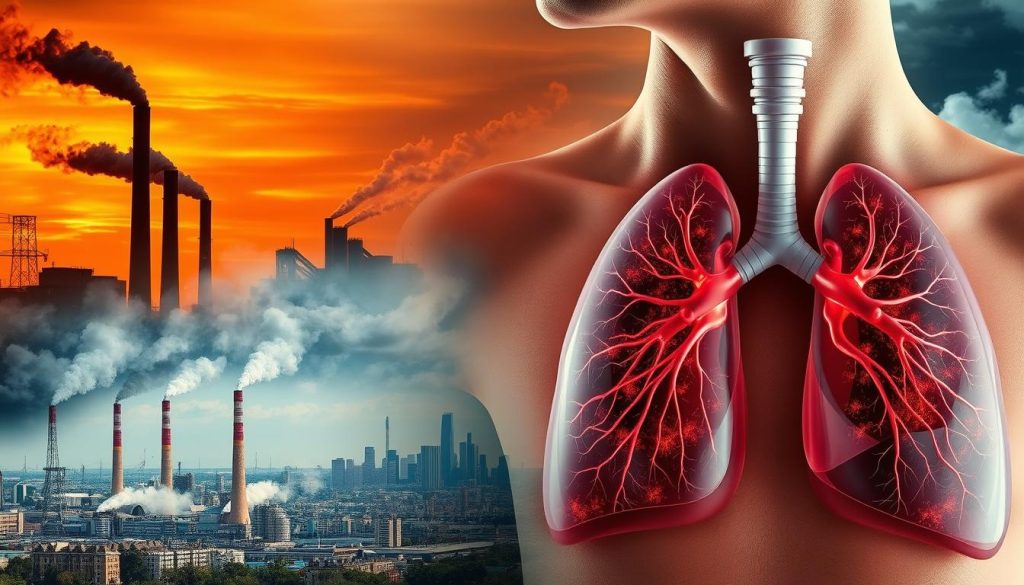
| Risk Factor | Impact on Non-Smokers | Possible Preventative Measures |
|---|---|---|
| Secondhand Smoke | Increases risk of lung cancer by 20-30% | Avoid environments with active smoking |
| Radon Exposure | Second leading cause of lung cancer | Test and mitigate radon in homes |
| Industrial Pollutants | Varies by exposure level and chemical type | Advocate for stricter pollution controls |
| Asbestos Fibers | Can cause mesothelioma, a type of lung cancer | Ensure safe removal from older buildings |
Changes in Voice or Persistent Hoarseness
Spotting early signs of lung cancer, like voice changes or persistent hoarseness, is key. These symptoms often mean more than just a cold or allergies. They can show that lung cancer has touched the laryngeal nerves.
Exploring the Causes of Hoarseness
Hoarseness or a raspy voice can come from many things. But with lung cancer, it usually means a tumor is pressing on the laryngeal nerves. These nerves help our voice work right, and problems with them can cause big voice changes.
Other reasons for persistent hoarseness include thyroid issues, acid reflux, and infections. But lung cancer is a big worry, especially for those at risk.
Why Early Diagnosis is Crucial
Finding lung cancer vocal symptoms like hoarseness early is very important. The sooner lung cancer is caught, the better the treatment works. This means a better chance of beating the disease.
Don’t ignore changes in your voice. Getting checked out by a doctor is crucial. It helps find out if cancer is there or not.
Here’s why catching lung cancer early matters:
| Stage at Diagnosis | Survival Rate | Treatment Options |
|---|---|---|
| Early (Localized) | 60-70% | Surgery, targeted therapy |
| Advanced (Metastasized) | 10-15% | Chemotherapy, palliative care |
Diagnostic Tests for Early Detection of Lung Cancer
The path to early lung cancer detection is filled with advanced lung cancer diagnostic tests. These tools help spot cancer early and make cancer screening more effective. Each test has its own use and works best in certain situations.
A Chest X-ray is often the first step in looking for lung issues. But, CT scans give a clearer view and are key in early lung cancer detection. Using these with PET scans and biopsies gives a full picture of cancer areas.
Using different tests together helps find lung cancer early. This improves patient outcomes by acting quickly.
Let’s dive deeper into these tests:
- Chest X-rays: Quick and non-invasive, good for first checks.
- CT scans: Show detailed images, key for finding small tumors.
- PET scans: Spot high cell activity, often cancer.
- Biopsies: Confirm cancer through tissue samples.
Here’s a comparison of these important tests:
| Test | Purpose | Detail Provided | Use in Early Detection |
|---|---|---|---|
| Chest X-ray | Initial assessment | General abnormalities | Limited |
| CT Scan | Detailed imaging | High-resolution images | Highly effective |
| PET Scan | Metabolic activity | Cell activity patterns | Used alongside CT |
| Biopsy | Definitive diagnosis | Cellular level exam | Critical for confirmation |
It’s crucial for doctors and patients to know how these cancer screening methods work. They’re not just for finding cancer but also for planning treatment.
Lung Cancer Symptoms: Early Detection and Prevention
Lung cancer is a big health issue globally. But, early detection and lung cancer prevention can make a big difference. It’s key to know and use good prevention methods.
The Role of Lifestyle Choices in Reducing Risk
Good lifestyle choices are key to lower lung cancer risk. Quitting smoking and avoiding secondhand smoke are important. Eating lots of fruits and veggies and staying active also help.
For more on symptoms and why early medical help is crucial, check here.
Screening and Regular Medical Check-Ups
Getting regular lung cancer screening is vital for those at high risk. This includes long-term smokers and those with lung cancer in their family. Early detection is key to effective treatment.
Here’s a look at how early detection can improve survival rates:
| Stage of Detection | Survival Rate Increase | Recommended Screening Interval |
|---|---|---|
| Early (Stage I) | Up to 92% | Annually |
| Late (Stage III or IV) | Below 36% | N/A |
In summary, combining smart lifestyle choices with regular medical checks is key to fighting lung cancer. These steps help both patients and doctors act fast. This can lead to better treatment chances and health outcomes.
Conclusion
We’ve explored lung cancer symptoms, from coughs and chest pain to weight loss and fatigue. Spotting these signs early is key to combating lung cancer. It boosts treatment success and better outcomes. An informed public is a strong ally in the battle against lung cancer.
But knowing is just the start. Taking action is crucial. It’s not just about knowing risks; it’s about taking steps to stay healthy. This includes regular check-ups, talking health changes with doctors, and making lifestyle choices that help lung health.
Let’s wrap up by saying that every step we take to learn about lung cancer helps. By being proactive, we can control our health journey. This helps in finding and treating lung cancer early. Let’s all make lung health a priority, watch for signs, and get medical help when needed. Together, we can build a healthier world, one breath at a time.
FAQ
Q: What Are the Early Signs of Lung Cancer to Watch Out For?
A: Early signs of lung cancer include a persistent cough and chest pain. You might also experience shortness of breath, wheezing, and fatigue. Unexplained weight loss and coughing up blood are other signs. Catching these symptoms early is key for timely medical care.
Q: How Common Is Lung Cancer?
A: Lung cancer is a common cancer worldwide. It has high incidence and mortality rates. Knowing this helps us understand the need for awareness and education.
Q: Which Factors Increase the Risk of Developing Lung Cancer?
A: Several factors increase lung cancer risk. These include smoking, secondhand smoke, and radon gas exposure. Occupational hazards and a family history of lung cancer also play a role. Being aware of these risks helps in taking preventive steps.
Q: How Can a Persistent Cough Indicate Lung Cancer?
A: A cough that lasts for weeks or changes in character is a warning sign. If it’s accompanied by blood or significant mucus, see a doctor. This could be a sign of lung cancer.
Q: What Type of Chest Pain is Associated with Lung Cancer?
A: Lung cancer chest pain is dull and aching. It gets worse with deep breathing, coughing, or laughing. This pain is different from sharp pains caused by other issues.
Q: Can Shortness of Breath Be a Symptom of Lung Cancer?
A: Yes, shortness of breath can be a lung cancer symptom. It’s especially concerning if it happens without exertion or gets worse over time. Look out for other symptoms like chest pain or a persistent cough.
Q: Are Wheezing and Stridor Common in Lung Cancer Patients?
A: Wheezing and stridor can happen if lung cancer blocks airways or causes inflammation. Recognizing these sounds is important. It could lead to an early cancer diagnosis.
Q: Is Fatigue a Sign of Lung Cancer?
A: Yes, persistent fatigue that doesn’t improve with rest might be a lung cancer symptom. It’s often more severe than usual tiredness. This symptom is common but should not be ignored.
Q: What Causes Weight Loss in Lung Cancer Patients?
A: Unexplained weight loss in lung cancer patients can be due to a decreased appetite or changes in metabolism. It’s significant if it’s not due to dieting or lifestyle changes.
Q: When Should Someone Seek Help for Coughing Up Blood?
A: Always seek medical help for coughing up blood, known as hemoptysis. While it might be benign, it could also indicate a serious condition like lung cancer.
Q: How Do Frequent Lung Infections Relate to Lung Cancer?
A: Frequent lung infections can be a sign of lung cancer. Tumors can make the lungs more prone to infections. If you keep getting lung infections, get a detailed medical check-up.
Q: What Does Bone Pain Indicate in Lung Cancer Patients?
A: Bone pain in lung cancer patients often means the cancer has spread to the bones. It’s persistent and worsens with movement, especially at night. This pain is a sign of cancer spread.
Q: Can Non-Smokers Get Lung Cancer?
A: Yes, non-smokers can also get lung cancer. Secondhand smoke, environmental toxins, radon exposure, and genetic predispositions are risk factors. These factors can increase risk in non-smokers.
Q: How Can Lung Cancer Affect Your Voice?
A: Lung cancer can cause hoarseness or voice changes. This happens if it affects the nerves controlling the larynx or if there’s a tumor in the lung’s upper regions. Persistent hoarseness needs investigation.
Q: What Diagnostic Tests Help With Early Detection of Lung Cancer?
A: Tests for early lung cancer detection include chest X-rays and CT scans. PET scans, bronchoscopy, and tissue biopsies are also used. These tests can catch lung cancer early, when it’s more treatable.
Q: How Can Early Detection and Prevention of Lung Cancer Be Achieved?
A: Early detection improves with regular medical screenings and symptom awareness. Prevention involves quitting smoking, avoiding carcinogens, and staying healthy through diet and exercise.












